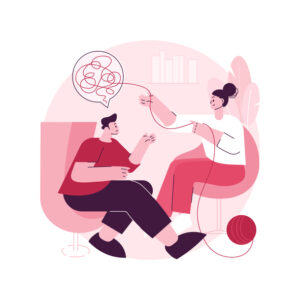Cognitive Behavioural Therapy, or CBT as it is usually called, is a structured, short-term therapy approach designed to help people manage a variety of mental health conditions. Developed in the 1960s, CBT has since become widely used for treating a variety of mental health issues, including anxiety, depression, and stress. The main principle of CBT is that our thoughts, feelings, and behaviours are interconnected, and changing one can positively affect the others. CBT is one of the most researched and widely used forms of psychotherapy, especially for issues like anxiety, depression, and stress. CBT was the first psychotherapy largely identified as evidence-based in most clinical guidelines. It dominates the international guidelines for psychosocial treatments
Key Principles of CBT
1. Understanding the Connection Between Thoughts, Feelings, and Behaviours
At the core of CBT is the idea that our thoughts, feelings, and behaviours influence each other. For example, if someone constantly thinks, “I’m not good enough,” they might feel sad or anxious and, as a result, may withdraw from social activities or avoid new challenges. This thought-feeling-behaviour loop can become a cycle that reinforces negative thinking patterns. CBT teaches people to break this cycle by examining and changing unhelpful thoughts, leading to healthier emotions and behaviours.
2. Identifying Negative Thought Patterns
Another essential part of CBT is recognizing and challenging negative or unhelpful thoughts. These can be automatic thoughts that occur without us even realizing, often leading to distorted thinking. Examples of these thought distortions include “all-or-nothing” thinking (viewing situations as entirely good or bad), catastrophizing (expecting the worst to happen), or mind reading (assuming you know what others are thinking about you). Through CBT, people learn to identify these patterns, question their validity, and replace them with more balanced, realistic thoughts.
3. Behavioural Activation and Exposure Therapy
Besides focusing on thoughts, CBT also includes techniques for changing behaviour. Behavioural activation is commonly used to help people increase engagement in positive activities that they may have been avoiding due to feelings of depression or anxiety. Similarly, exposure therapy, a CBT technique often used for anxiety, involves gradually facing fears in a safe, structured way. By taking small steps to confront fears, people often find that their anxiety decreases over time, which builds confidence and resilience.
4. Self-Monitoring
CBT emphasises the importance of consistency in recognizing thoughts, challenging them, and practicing new behaviours. Keeping a journal or a thought log can be helpful for tracking progress, identifying patterns, and adjusting as needed. Your goals should be the things that you want. Start thinking what do you want.
How CBT Works in Practice
CBT usually involves a set number of sessions (6-10) with a trained therapist, such as psychologist, clinical social worker or mental health occupational therapist, who guides the individual through exercises and discussions to identify and reframe negative thoughts. During each session, the therapist may assign “homework” exercises, such as keeping a thought diary, practicing relaxation techniques, or gradually facing feared situations. These practical exercises help people apply what they’ve learned in therapy to real-life situations.
Benefits of CBT
One of the biggest advantages of CBT is its versatility and adaptability. It can be tailored to individuals of different ages, backgrounds, and needs. Additionally, CBT is generally time-limited, meaning most people see significant improvement in just a few months. CBT has been shown to be effective not only for mental health conditions but also for managing stress and improving overall life satisfaction.
In conclusion, CBT is a practical approach to mental health, teaching individuals to recognize and change unhelpful thoughts and behaviours. It is effective in helping people manage symptoms and develop skills they can use long-term, as it helps understanding how our thoughts influence our emotions and actions. By focusing on making small but meaningful changes in thinking and behaviour, CBT helps people take control of their mental health and develop tools to cope with future challenges. Successful change depends largely on common sense. So, change is possible, and we are here to support you.
Author: Nenad Bakaj, MHumServ (RehabCouns), BSocWk, DipAppSci (Comm&HumServ), AMHSW, MAAC, MAASW, JP (Qld)
Nenad Bakaj is a Brisbane based Clinical Counsellor, Accredited Mental Health Social Worker, Life Coach and Bigger Bite Out Of Life Trainer with a keen interest in positive psychology, mental health and wellbeing, and is continually developing his professional skills and knowledge. Nenad enjoys working with adolescents and young adults, as well as older clients, and feels it is a privilege to be able to support them.
To make an appointment with Nenad Bakaj, try Online Booking. Alternatively, you can call Vision Psychology Brisbane on (07) 3088 5422 or M1 Psychology Loganholme on (07) 3067 9129.
References
Beck, J. S. (2011). Cognitive Behaviour Therapy: Basics and Beyond (2nd ed.). New York: Guilford Press.
David, D. (2018). The Psychology of Cognitive Behavioural Therapy. Cluj-Napoca: Babes-Bolyai University Press.
Edelman, S. (2008). Change Your Thinking (2nd ed.). ABC Books. Fenn, K., & Byrne, M. (2013). The key principles of cognitive behavioural therapy. InnovAiT, 6(9), 579-585.
Joseph, A. (2009). Cognitive Behavioural Therapy. Capstone Publishing Ltd.
